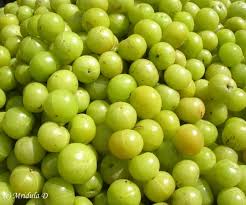Phyllanthus Emblica நெல்லிக்கனி
http://www.sidhhaherbs.blogspot.com
Amla Tree - Nellikai, Phyllanthus Embilca (Emblica offcinalis ...
 Dear friends I sincerely would like to appeal to the Malaysian Government to consider to plant as much Phylanthus Emblica on road sides to save the citizens from illness and to give shade and also to stop the erosion of the land, during heavy rain.
Dear friends I sincerely would like to appeal to the Malaysian Government to consider to plant as much Phylanthus Emblica on road sides to save the citizens from illness and to give shade and also to stop the erosion of the land, during heavy rain.
The herb Phyllanthus emblica has gained interest as a potiential treatment for human bone disorders as well as diabetes patients.
The plant starts yielding after 4-5 years of planting. A mature plant gives (10 years old) around 60-70 kg of fruit per year. Per kg contains 15-20 fruits. A well-maintained tree gives yield up to around 70 years. The average fruit yield is 200kg per year in a well grafted fully mature tree. It costs around Rs 6 per kg. For major medicinal crops banks including NABARD arrange loans for the cost of cultivation to farmers. So all farmers will use this opportunity and get better returns. Because the present production level in India is too low compared to the population. Now we are producing only 2 lakhs tonnes/year only. By creating awareness among people about the health benefits of Amla, We can attain great demand. That time we need daily 2 lakhs tonnes of fruits.
Amla strengthens the body, expels toxins from the body
and improves the defense mechanism of the body.
It is an essential vitamin to improve eyesight
Weakness of body, heart, and mind shall be dispelled by taking fresh amla juice in between meals.
Massaging the head with amla oil induces sound sleep and
is good for hair. prevents premature graying of hair.
Amla is a powerful food for the brain.
Studies show that Amla helps lower cholesterol
Amla also helps maintain the functioning of the liver
Increases Hemoglobin and red blood cell count
Useful for Cough, Bronchitis, Asthma
For both men and women, Amla helps maintain
reproductive area health. Amla is excellent for
strengthening the roots of your hair and maintaining its
color and luster.
Dear friends You can buy this rare herb from Brickfields in Malaysia and please make use of it.
physicianpackiam
http://www.sidhhaherbs.blogspot.com
http://www.sidhhaherbs.blogspot.com
Amla Tree - Nellikai, Phyllanthus Embilca (Emblica offcinalis ...
The Indian gooseberry (Phyllanthus emblica, syn. Emblica officinalis) is a deciduous tree of the Euphorbiaceae family. It is known for its edible fruit of the same name.
Common names of this tree include amalaka in Sanskrit, amla (आँवला) in Hindi, Nellikai in Tamil , amlaki in Bengali, and amala in Nepal Bhasa
.
The herb Phyllanthus emblica has gained interest as a potential treatment for human bone disorders as well as diabetes patients.The herb Phyllanthus emblica has gained interest as a potiential treatment for human bone disorders as well as diabetes patients.
The plant starts yielding after 4-5 years of planting. A mature plant gives (10 years old) around 60-70 kg of fruit per year. Per kg contains 15-20 fruits. A well-maintained tree gives yield up to around 70 years. The average fruit yield is 200kg per year in a well grafted fully mature tree. It costs around Rs 6 per kg. For major medicinal crops banks including NABARD arrange loans for the cost of cultivation to farmers. So all farmers will use this opportunity and get better returns. Because the present production level in India is too low compared to the population. Now we are producing only 2 lakhs tonnes/year only. By creating awareness among people about the health benefits of Amla, We can attain great demand. That time we need daily 2 lakhs tonnes of fruits.
Amla strengthens the body, expels toxins from the body
and improves the defense mechanism of the body.
It is an essential vitamin to improve eyesight
Weakness of body, heart, and mind shall be dispelled by taking fresh amla juice in between meals.
Massaging the head with amla oil induces sound sleep and
is good for hair. prevents premature graying of hair.
Amla is a powerful food for the brain.
Studies show that Amla helps lower cholesterol
Amla also helps maintain the functioning of the liver
Increases Hemoglobin and red blood cell count
Useful for Cough, Bronchitis, Asthma
As a rejuvenative herb, Amla nourishes all the body
tissues and accelerates the cell regeneration process. It
also cleanses plasma and
blood.
tissues and accelerates the cell regeneration process. It
also cleanses plasma and
blood.
For both men and women, Amla helps maintain
reproductive area health. Amla is excellent for
strengthening the roots of your hair and maintaining its
color and luster.
Dear friends You can buy this rare herb from Brickfields in Malaysia and please make use of it.
physicianpackiam
http://www.sidhhaherbs.blogspot.com
No comments:
Post a Comment